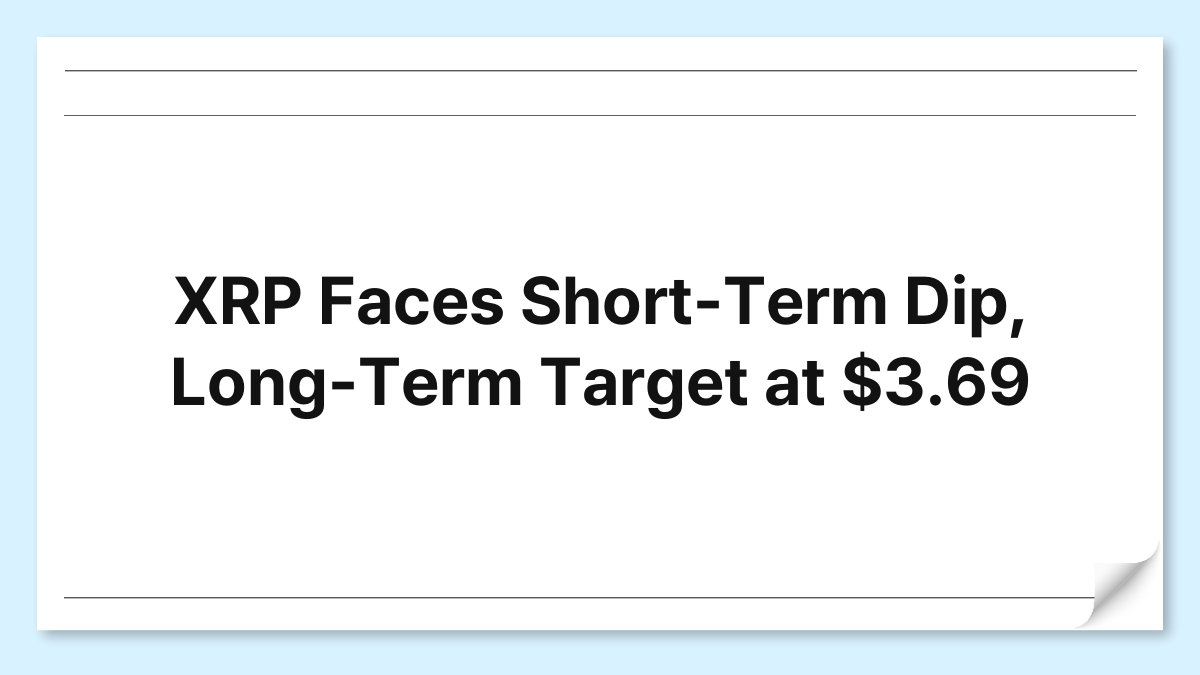[케이브릿지 미디어/Jay Son] XRP, the digital asset associated with Ripple, is currently experiencing a short-term dip in its market value.
This fluctuation has raised concerns among investors and traders about the immediate future of XRP.
However, despite this temporary setback, many analysts maintain a long-term price target of $3.69 for XRP.
This article delves into the factors contributing to the recent decline and examines the underlying trends that could support a recovery and eventual price increase.
Readers will gain insights into market dynamics, technological advancements, regulatory considerations, and potential investment strategies related to XRP.
The analysis aims to provide a comprehensive understanding of the current state of XRP and its prospects.
Understanding the Current Market Dynamics
Recent Price Movements of XRP
XRP has faced significant volatility in recent weeks, reflecting broader trends in the cryptocurrency market.
The asset’s price recently dipped below critical support levels, prompting concerns among investors.
This decline can be attributed to various factors, including market sentiment and macroeconomic conditions.
Investors should note that price fluctuations are not uncommon in the cryptocurrency space, and understanding these movements is crucial for informed decision-making.
Technical analysis of XRP’s price action reveals that it has been influenced by both external market conditions and internal developments within the Ripple ecosystem.
The correlation between XRP and Bitcoin remains strong, as Bitcoin’s price often dictates the overall market trend.
Consequently, XRP’s recent dip can be viewed within the context of Bitcoin’s own struggles to maintain upward momentum.
In addition to Bitcoin’s influence, XRP has also faced challenges stemming from regulatory scrutiny.
The ongoing legal battle between Ripple and the U.S.
Securities and Exchange Commission has created uncertainty around the asset’s classification and future viability.
This uncertainty can lead to increased selling pressure as investors reassess their positions.
Factors Impacting XRP’s Short-Term Performance
The short-term performance of XRP is influenced by a myriad of factors that investors must consider.
Market sentiment plays a pivotal role, as fear and uncertainty can drive price declines.
The recent dip in XRP’s value coincided with a general downturn in the cryptocurrency market, as negative news and regulatory developments prompted a risk-off approach among traders.
Moreover, macroeconomic factors such as inflation rates and interest rate hikes can impact investor behavior.
When traditional markets face uncertainty, investors may seek to liquidate their cryptocurrency holdings to secure cash or invest in safer assets.
This trend has been evident in recent weeks, as many investors have opted to reduce their exposure to riskier assets, including XRP.
Another critical factor is the competitive landscape within the cryptocurrency sector.
As new projects emerge and existing ones evolve, XRP faces increased competition for market share.
Innovations in blockchain technology and the rise of decentralized finance have attracted attention away from traditional assets like XRP.
Investors should monitor these developments closely, as they can significantly impact XRP’s market positioning.
Technical Analysis and Price Predictions
Conducting a technical analysis of XRP’s price movements can provide valuable insights into potential future trends.
Chart patterns, support and resistance levels, and trading volumes are essential components of this analysis.
Currently, XRP is trading below its key support levels, which may indicate further downside potential if selling pressure continues.
However, technical indicators such as the Relative Strength Index suggest that XRP may be oversold.
An oversold condition often precedes a price correction, where the asset may rebound as buyers step in.
Investors should remain vigilant for signs of a reversal, as this could signal a potential buying opportunity.
Price predictions for XRP vary widely among analysts, with some projecting a return to previous highs while others foresee further declines.
The long-term target of $3.69 is based on fundamental analysis, which considers Ripple’s partnerships, technological advancements, and market adoption.
Investors should weigh these factors against short-term volatility when making decisions.
Ripple’s Technological Innovations
Advancements in RippleNet
RippleNet, the network that facilitates cross-border payments, continues to innovate and expand its capabilities.
The platform’s focus on speed and efficiency has attracted numerous financial institutions seeking to streamline their payment processes.
These advancements position Ripple as a leader in the blockchain payment space and could drive demand for XRP in the long term.
The integration of new technologies, such as on-demand liquidity, enhances RippleNet’s value proposition.
This feature allows financial institutions to access liquidity in real time, reducing the need for pre-funding accounts in destination currencies.
As more banks and payment providers adopt RippleNet, the demand for XRP as a bridge currency is likely to increase.
Furthermore, Ripple’s commitment to regulatory compliance is essential in building trust with financial institutions.
By actively engaging with regulators and adhering to legal frameworks, Ripple aims to create a sustainable ecosystem for its technology.
This approach could mitigate some of the concerns surrounding XRP’s classification and enhance its long-term viability.
Collaborations and Partnerships
Ripple has established strategic partnerships with various financial institutions and payment providers worldwide.
These collaborations are crucial for expanding the adoption of XRP and RippleNet.
By integrating Ripple’s technology into their existing systems, partners can offer enhanced payment solutions to their customers, thereby driving demand for XRP.
The ongoing partnerships with major banks and payment processors signal a growing acceptance of blockchain technology in traditional finance.
As these institutions recognize the benefits of using XRP for cross-border transactions, the asset’s utility is likely to increase.
This trend could contribute to a more stable price environment for XRP in the future.
Additionally, Ripple’s focus on emerging markets presents significant growth opportunities.
Many developing countries face challenges related to slow and costly cross-border payments.
Ripple’s technology offers a solution to these issues, positioning XRP as a viable alternative for financial institutions operating in these regions.
Regulatory Considerations
Regulatory developments are a critical factor influencing the future of XRP.
The ongoing legal battle with the U.S.
Securities and Exchange Commission has created uncertainty around XRP’s classification as a security or a commodity.
This uncertainty has implications for its trading status and broader market acceptance.
While the outcome of the legal proceedings remains uncertain, Ripple’s proactive approach to regulatory compliance may serve to mitigate some risks.
By engaging with regulators and advocating for clear guidelines, Ripple aims to create a more favorable environment for XRP and its ecosystem.
Investors should remain informed about regulatory changes, as these developments can significantly impact market sentiment and price movements.
A favorable ruling for Ripple could lead to increased adoption of XRP and a subsequent rise in its value.
Conversely, an unfavorable outcome may result in heightened selling pressure and further price declines.
Market Sentiment and Investor Behavior
Understanding Market Psychology
Investor behavior is heavily influenced by market sentiment, which can shift rapidly in the cryptocurrency space.
Fear, uncertainty, and doubt can drive prices down, while bullish sentiment can lead to rapid price increases.
Understanding these psychological factors is essential for investors looking to navigate the volatile landscape of cryptocurrencies.
The current dip in XRP’s price reflects a broader trend of risk aversion among investors.
Many traders are reevaluating their positions in light of recent market developments.
This cautious approach is common during periods of uncertainty, as investors seek to minimize potential losses.
However, market sentiment can change quickly.
Positive news or developments related to Ripple or XRP could trigger a reversal in sentiment, leading to increased buying activity.
Investors should remain attentive to market signals and be prepared to adjust their strategies accordingly.
The Role of Social Media and News
Social media and news outlets play a significant role in shaping market sentiment.
Information spreads rapidly through these channels, influencing investor perceptions and decisions.
Positive or negative news about Ripple or XRP can lead to swift price movements, as traders react to the latest developments.
Monitoring social media sentiment can provide valuable insights into potential price trends.
Platforms such as Twitter and Reddit often serve as barometers for investor sentiment, with discussions around XRP’s future gaining traction among the community.
However, investors should approach social media with caution.
Misinformation and hype can lead to irrational decision-making.
It is essential to verify information and rely on credible sources when assessing market developments.
Long-Term Investment Strategies
Investors considering XRP as part of their portfolio should adopt a long-term perspective.
While short-term price fluctuations can be disconcerting, a focus on the asset’s fundamentals and long-term potential is crucial.
Diversification is a key strategy for managing risk in any investment portfolio.
By allocating funds across multiple assets, investors can mitigate the impact of volatility in any single asset, including XRP.
Additionally, dollar-cost averaging can be an effective approach for investors looking to accumulate XRP over time.
By investing a fixed amount at regular intervals, investors can reduce the impact of price fluctuations and build a position in XRP without attempting to time the market.
The Global Regulatory Landscape
Evolving Regulations in Major Markets
The regulatory environment for cryptocurrencies is evolving rapidly across major markets.
In the United States, the SEC’s actions against Ripple have prompted discussions about the need for clearer guidelines regarding the classification of digital assets.
This ongoing dialogue could shape the future of XRP and its acceptance in the U.S.
market.
In contrast, regions such as the European Union are moving towards more comprehensive regulatory frameworks for cryptocurrencies.
The Markets in Crypto-Assets Regulation aims to create a harmonized approach to digital assets, which could benefit projects like Ripple by providing clarity and legal certainty.
Asia presents a mixed landscape of regulatory approaches.
Countries such as Singapore have embraced blockchain technology and cryptocurrencies, fostering innovation and growth.
Others, like China, have taken a more restrictive stance.
These varying approaches highlight the importance of understanding regional regulations when assessing the potential for XRP’s adoption.
The Impact of International Cooperation
International cooperation among regulators is essential for creating a cohesive framework for cryptocurrencies.
As digital assets transcend borders, a coordinated approach can help address challenges related to compliance and security.
Ripple’s focus on regulatory engagement positions it well to navigate these complexities.
Collaborative efforts among regulators can lead to the establishment of best practices and standards for cryptocurrencies.
This could enhance the legitimacy of XRP and foster greater confidence among investors and financial institutions.
Investors should stay informed about international regulatory developments, as these changes can have far-reaching implications for the cryptocurrency market.
A supportive regulatory environment could pave the way for increased adoption of XRP and other digital assets.
Navigating Regulatory Risks
Investors must be aware of the regulatory risks associated with XRP and the broader cryptocurrency market.
Changes in regulations can lead to increased scrutiny and potential limitations on trading and usage.
To navigate these risks, it is essential for investors to conduct thorough research and remain informed about ongoing legal developments.
Understanding the potential implications of regulatory changes can help investors make more informed decisions regarding their XRP holdings.
Developing a proactive approach to risk management is crucial.
Investors should consider diversifying their portfolios and adopting strategies that account for potential regulatory impacts.
This may involve allocating funds to a mix of assets that can withstand regulatory challenges while still capturing potential upside in the cryptocurrency market.
Conclusion: Future Outlook for XRP
The future outlook for XRP remains a topic of considerable debate among analysts and investors.
While the current short-term dip raises questions about the asset’s immediate prospects, the long-term target of $3.69 reflects optimism about Ripple’s potential.
Investors should consider the various factors influencing XRP’s performance, including technological advancements, regulatory developments, and market sentiment.
By maintaining a long-term perspective and adopting sound investment strategies, investors can position themselves to benefit from potential future growth in XRP’s value.
As the cryptocurrency landscape continues to evolve, staying informed and adaptable will be essential for navigating the complexities of XRP and the broader market.
The journey ahead may be challenging, but the potential rewards could be significant for those willing to engage with the evolving dynamics of the cryptocurrency space.








